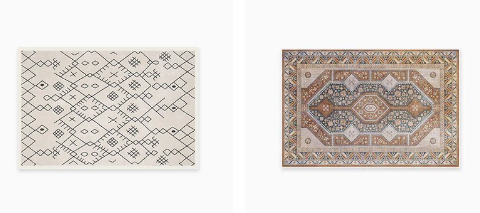Traditional rugs have long been cherished for their ability to add warmth, beauty, and a sense of cultural heritage to any space. These intricately crafted rugs have stood the test of time, captivating homeowners and interior designers alike. In this article, we delve into the world of traditional rugs, exploring their rich history, craftsmanship techniques, and the ways in which they effortlessly blend heritage with contemporary style.
The Timeless Beauty of Traditional Rugs
A Tapestry of Culture and History
Traditional rugs are more than mere floor coverings; they are cultural artifacts that tell stories of generations past. Each rug style, from the ornate Persian rugs to the geometric patterns of tribal rugs, reflects the unique heritage and traditions of the regions they originate from. These rugs serve as visual reminders of the rich tapestry of human history, preserving ancient techniques and designs that have been passed down through centuries.
Intricate Designs and Exquisite Details
What sets traditional rugs apart is the level of artistry and attention to detail that goes into their creation. Skilled artisans spend countless hours hand-weaving each rug, using techniques perfected over generations. The intricate designs, often inspired by nature, folklore, or religious symbolism, are meticulously crafted with precision and care. The result is a masterpiece that showcases the craftsmanship and artistic expression of its maker.
Traditional Rugs: A Testament to Craftsmanship
The Art of Handweaving
Traditional rugs are predominantly made through the art of handweaving, a technique that requires immense skill and patience. Artisans carefully select the finest materials, such as wool or silk, and meticulously weave each knot, creating a durable and beautiful rug. This process, passed down through generations, ensures that every rug is a unique work of art, reflecting the expertise and dedication of the weaver.
Natural Materials for Lasting Beauty
One of the defining features of traditional rugs is their use of natural materials. Wool, sourced from sheep and renowned for its durability and softness, is a common choice. Silk, with its luxurious sheen and delicate texture, is often used in fine rugs. These natural fibers not only contribute to the longevity of the rugs but also provide a distinct feel and aesthetic appeal that cannot be replicated by synthetic materials.

Traditional Rugs in Modern Design
Adding Character and Depth
In the world of modern interior design, traditional rugs have found their place as statement pieces that add character and depth to any space. The intricate patterns and vibrant colors of traditional rugs create a striking focal point, elevating the overall aesthetics of a room. Whether placed in a contemporary living room, a cozy bedroom, or a stylish office, traditional rugs effortlessly bridge the gap between old-world charm and modern style.
Versatility and Adaptability
One of the remarkable qualities of traditional rugs is their versatility. These rugs can seamlessly fit into a wide range of design styles, from traditional to eclectic, minimalist to bohemian. Their timeless appeal allows them to be mixed and matched with various furniture and decor choices, creating a harmonious and visually captivating space. Traditional Rugs serve as a unifying element, tying together different design elements and adding a touch of elegance to any room.
Preserving Heritage and Supporting Artisans
Sustaining Cultural Traditions
By incorporating traditional rugs into our homes, we actively participate in the preservation of cultural heritage. These rugs carry within them the traditions, stories, and artistry of the communities that produce them. When we choose traditional rugs, we not only embrace their beauty but also honor the rich history and cultural significance associated with them. This appreciation helps ensure that these ancient craft techniques continue to thrive and evolve.
Empowering Artisans and Local Communities
The production of traditional rugs often involves skilled artisans and local communities, whose livelihoods depend on this ancient craft. By supporting traditional rug makers, we contribute to the economic sustainability of these communities. Additionally, purchasing traditional rugs from ethical sources ensures fair trade practices, empowering artisans and promoting their well-being.
Conclusion
Traditional rugs are not mere floor coverings; they are works of art that embody cultural heritage, exquisite craftsmanship, and timeless beauty. Their intricate designs and meticulous details tell stories of the past, while their versatility allows them to seamlessly integrate into modern design aesthetics. By choosing traditional rugs, we embrace the richness of cultural traditions, support artisans, and add a touch of heritage to our living spaces. These rugs serve as more than decorative elements; they are tangible connections to our collective history, reminding us of the beauty that can be found in tradition.
